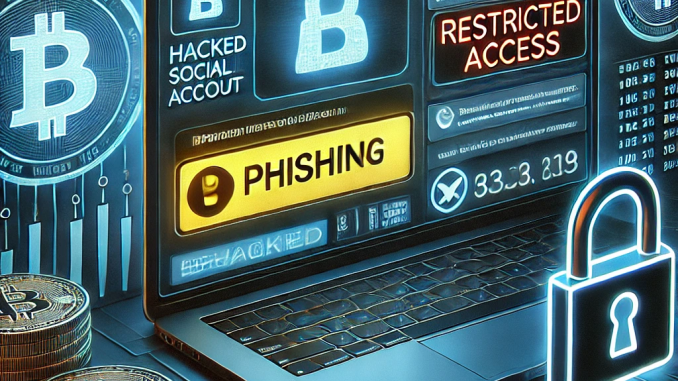
As the cryptocurrency industry grows, so do the security risks associated with it. Recent events have highlighted major vulnerabilities in crypto security, including high-profile social media hacks and government-imposed bans on exchanges.
From the hijacking of BBC broadcaster Nick Robinson’s X (Twitter) account to spread a fake cryptocurrency scam, to Russia blocking the BestChange exchange platform, these incidents underscore the growing challenges faced by crypto investors, platforms, and regulatory bodies.
In this blog, we explore how these security threats are impacting the industry and what steps users can take to protect their assets and information.
Social Media Hacks and Crypto Scams on the Rise
Nick Robinson’s X (Twitter) Account Hijacked
BBC journalist Nick Robinson, a well-known broadcaster, recently fell victim to a social media hack that was used to promote a fake cryptocurrency called “$TODAY” on the Solana blockchain.
Hackers gained control of his X (formerly Twitter) account and posted fraudulent investment opportunities, urging his followers to click on malicious links. Fortunately, Robinson regained control of his account and quickly warned his audience about the scam.
This incident is not an isolated case—many high-profile figures, including politicians, business leaders, and celebrities, have had their accounts compromised to spread fake crypto investments.
How These Hacks Work
Crypto scammers use various tactics to hijack social media accounts and deceive investors:
• Phishing Attacks: Hackers send fraudulent emails or messages pretending to be from a trusted platform to steal login credentials.
• SIM Swapping: Attackers trick mobile carriers into transferring a user’s phone number to a different SIM card, gaining access to two-factor authentication (2FA) codes.
• Malware & Keyloggers: Malicious software installed on a device can track keystrokes and steal sensitive information, including crypto wallet keys.
Why Crypto Investors Are Targeted
• Crypto transactions are irreversible, making them attractive to scammers.
• The decentralized nature of crypto means there’s no central authority to reverse fraudulent transactions.
• The hype around new tokens and projects makes it easier to create convincing scams.
Russia Blocks Crypto Exchange BestChange
While social media hacks are a growing problem, governments are also tightening their grip on crypto exchanges, citing security and financial concerns.
BestChange Blocked by Russia’s Financial Regulator
Russia’s communications watchdog, Roskomnadzor, recently blocked access to BestChange, one of the country’s most widely used crypto exchange platforms.
Why Was BestChange Banned?
• Alleged Financial Violations: Russian authorities claim BestChange did not comply with financial regulations, though specific reasons remain unclear.
• Crackdown on Unregulated Exchanges: Russia is ramping up efforts to regulate crypto platforms, preventing illicit financial transactions.
• Potential Geopolitical Motives: Some analysts suggest that Russia may be trying to restrict capital flight, as citizens use crypto to bypass sanctions and economic restrictions.
Impact on Russian Crypto Users
With BestChange blocked, Russian crypto traders face:
• Fewer options for exchanging fiat to crypto.
• Increased risks from using unregulated peer-to-peer (P2P) platforms.
• Potential for VPN usage to bypass the ban, raising security concerns.
What These Incidents Mean for Crypto Security
1. Increased Risk for Crypto Investors
The rise in social media hacks and exchange bans means investors must be more vigilant. Cybercriminals are becoming more sophisticated, making it harder to spot scams.
2. Governments Are Taking a Tougher Stance
With regulatory bodies cracking down on unregistered exchanges, traders and investors may face increased scrutiny when moving funds.
3. Trust in Crypto Security Is Being Tested
Every high-profile hack and government intervention creates uncertainty in the crypto industry, making security a top priority for platforms and users alike.
How to Protect Yourself from Crypto Scams and Security Risks
For Social Media Users
• Enable Two-Factor Authentication (2FA): Use app-based 2FA (Google Authenticator, Authy) instead of SMS-based verification, which is vulnerable to SIM swaps.
• Use Strong, Unique Passwords: Avoid reusing passwords across multiple accounts and use a password manager.
• Be Skeptical of Investment Promotions: If a well-known figure suddenly promotes a crypto project, verify their official website and social media statements before taking action.
For Crypto Traders in High-Risk Jurisdictions
• Use Reputable Exchanges: Stick to regulated and well-known platforms that comply with security standards.
• Secure Your Crypto Assets: Use hardware wallets (Ledger, Trezor) instead of leaving funds on centralized exchanges.
• Stay Informed About Local Regulations: If you trade in a country with strict regulations, keep up with legal changes to avoid unexpected bans.
For Businesses and Crypto Platforms
• Improve Account Security: Crypto exchanges and platforms should invest in multi-layered security systems to prevent hacks.
• Educate Users: Platforms should provide clear guidelines on identifying phishing attempts and scams.
• Comply with Regulations: Exchanges operating in uncertain regulatory environments should work towards compliance to prevent shutdowns.
As crypto adoption continues to rise, so do security threats. The hacking of Nick Robinson’s X account and the ban on BestChange in Russia highlight the ongoing challenges facing the crypto industry.
To navigate this evolving landscape, investors, businesses, and regulators must prioritize security measures to protect assets and build trust in digital finance. By staying informed and proactive, crypto users can safeguard their investments and personal data in an increasingly volatile environment.